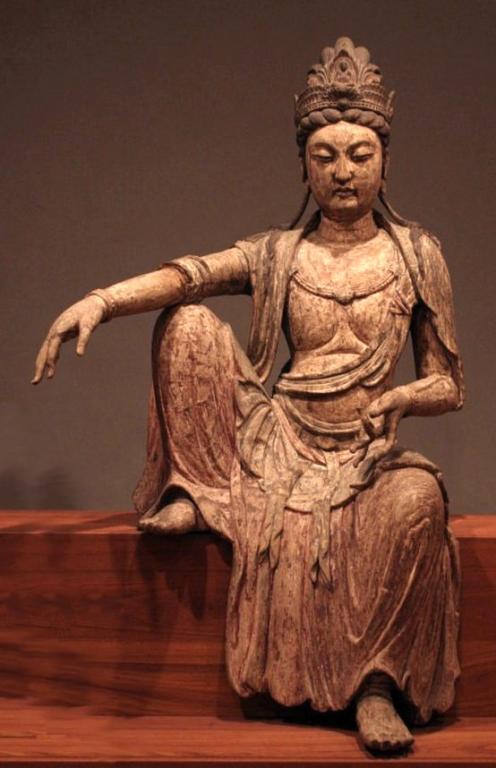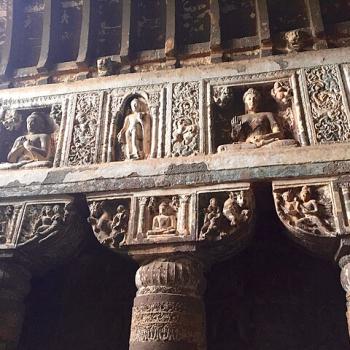THIRD PURE PRECEPT
Zen’s Shorthand for the Bodhisattva Vow
A talk delivered at
Empty Moon Zen‘s
Saturday morning Zoom gathering
To remind you.
The three pure precepts are derived from verse 183 in the Dhammapada, a collection of sayings attributed to Gautama Siddhartha, the Buddha of history. The verse goes: “Renounce all evil; practice all good; keep your mind pure—thus all the Buddhas taught.”
There we clearly see the first two of the pure precepts, ceasing from evil, and doing good.
The third line is rewritten and the fourth is dropped. I suggest that fourth line is unnecessary in the framing of the pure precepts, although its heart is retained as the precepts writ large. Critically that third line is shifted as part of the whole Mahayana project. The great way, of which Zen is a part.
After ceasing from evil. Or trying to understand and finding actions to match that understanding. After doing good. Or trying to understand and finding actions to match that understanding. Here we come to a critical turning. Our teacher Aitken Roshi suggests the rewriting of that line is a “shift from the ideal of personal perfection to the ideal of oneness with all beings.”
Taking them all together. The Zen teacher Daido Loori tells us that this new formulation is very significant. “’Not creating evil,’ ‘practicing good,’ and ‘actualizing good for others’” he writes, are the foundation “upon which all of the moral teachings of the Buddha are based. The life of each one of us.” I think this is true. It is, I find, the summation of the ethical or moral container of our way.
But three pure precepts doesn’t stop there. It is an invitation into something profound. While “cease from evil” is an invitation to turn our lives in a direction, and the “do good” is an expression of the harmonies of a realized life, that third line opens us into the dynamics of this mysterious life.
The most straightforward presentation of this third pure precept is “do good for others.” I’m also fond of the version “save the many beings.” Although we have to unpack that save part a little to fully appreciate the nuancing. Shunryu Suzuki’s version of the line is “I vow to live and be lived for the benefit of all beings” reveals the wonderful messiness of our way. Another friend suggests the line can be rendered simply “awaken.” I agree. But again, that begs a lot of unpacking.
At its heart this third of the pure precepts is about the heart of the Mahayana, a turn from a spirituality based in my own saving, a singular project. And by the bye, one I do not disdain, it is something wonderful. But in our way, that turning is into a profound realization we’re all in this together. Our loss. And our gain. Yours and mine, they cannot in any final analysis be unraveled.
The word for this sense, this call, ultimately this vow, is Bodhisattva. Bodhisattva is the expression of not precisely two, but not exactly one. It opens us to the dynamic of our understanding of that ancient human intuition which is expressed in the dharmic traditions as nonduality. And which modern spiritual scholars have seen is clearly found in all the great religions. As well as among people without any particular religion.
In the third pure precept we come to Bodhisattva mind and the Bodhisattva vow.
I understand that whenever he would give talks, the early Zen missionary to the barbarians of North America Nyogen Senzaki would always address his audience as “bodhisattvas.” A friend who knows his way around the dharma life, once suggested to me that when Senzaki did this, the sensei was throwing out a net, hoping to snare a wise heart or two.
To address each other as bodhisattvas is an expression of realization, and with that, an invitation. Not unlike a koan.
I sometimes say to someone who has done a small mitzvah, a kindness of one sort or another, “you’re a bodhisattva.” I hope in the same spirit. Okay, in my case maybe with a little bit of snark. But then I stand solidly within my age, and our times just drip with irony. Marx, I’ve heard, opined that history repeats itself, first as tragedy, then as farce. While it isn’t always clear where are today, tragedy or farce; there seems nonetheless always to be room for a little sarcasm.
Knowing us. You and me. Looking within and at each other and knowing yes there is bodhisattva – in reality, and in potential. But knowing the rest as well. People as foolish and greedy and hateful and overflowing with unhealthy opinions. You know, knowing the mess. For me that calls for a hint of irony when calling each other bodhisattvas. You know. Nothing like a good joke. Okay, for me, and thinking of what we are capable of, and what sometimes do, despite our bodhisattvaness; I’m not against even a bad joke.
And there is a joke here. When we say about any specific person, bodhisattva. At least in the sense of taking something that is in all the glory of the causes and conditions and decsions that have kept it going, you know, you or me. And then pushing it, prodding it, pulling it, shaping it, until we find something new. Same stuff, but new. Take your favorite villain. And can you then find the bodhisattva there? The Enlightenment being.
Me, I think of those invitations. And the precepts really are invitations. I think especially of this third of the pure precepts is inviting us into our true lives as bodhisattvas. And to what that actually means in a life. As vow, perhaps.
But let’s pause for a moment and consider the bodhisattva as an idea.
In its original use it appears to be what the Buddha, Gautama Siddhartha was called in the Jataka tales, those extracanonical stories of his previous lives. Mostly they’re children’s stories, and they sometimes offer heavy handed morals. They’re also fun, when they don’t take really weird turns. Okay that can be fun, too. The point for bodhisattva here, is that in these stories the being who will be Buddha has not fully realized that place, state, however you might want to describe it, but is on the way. Fully on the way. Maybe even more there than not.
The word bodhisattva shifted from that use in the tales, and quickly came to be the term of art to describe someone on the Buddha way. Specifically for one who has achieved bodhicitta, the mind of awakening. The term is developed in a text called the Ten Stage Sutra, itself collected as part of the Avatamsaka Sutra, the Flower Ornament.
Bodhicitta is a complicated experience. The desire for ourselves is natural. It is noticing the hurt of our lives and with that wanting something. Healing. Saving. Lots of good words out there. Each of course, a bit misleading. And each pointing. This deeply personal, all about me part, is probably always the first part. But that feeling, longing, is only dipping our toe into the lake. It isn’t enough. It turns out. We need the full dive. Which is to wish that healing, that saving for everyone.
And here’s the thing. When everyone is part of our desire for healing, for saving, for awakening; that is the mind of awakening.
In the family of the Great Way a bodhisattva is further understood as someone who has walked the way and has achieved awakening. But rather than passing from the world, vows to remain contaminated, to be a part, to know the hurt, and the longing, until all and everything can also enter the great awakening.
Now, in Zen this is a bit of a bait and switch. Back to the jokiness of our way.
Because we are all so intimately connected that one cannot achieve awakening without everyone and everything else. And there’s a further joke inside that joke. That is none of us has ever been separated. Not ever.
As the movie says “everything everywhere all at once.”
An Indian monk named Shantideva saw this all as a vow. You may recall vow. From one angle our precepts are vows. When I think of the third pure precept, Shantideva’s words echo in the phrase I vow to save all beings. I vow to heal all beings. I vow to awaken all beings.
He sang his vow:
May I be the doctor and the medicine
And may I be the nurse
For all sick beings in the world
Until everyone is healed.
May I become an inexhaustible treasure
For those who are poor and destitute;
May I turn into all things they could need
And may these be placed close beside them.
May I be a protector for those without one,
A guide for all travelers on the way;
May I be a bridge, a boat, and a ship
For all who wish to cross the water.
May I be an island for those who seek one
And a lamp for those desiring light;
May I be a bed for all who wish to rest
And a servant for all who want a servant.
May I be a wishing jewel, a magic vase,
Powerful mantras, and great medicine;
May I become a wish-fulfilling tree
And a cow of plenty for the world.
And like space
And all the great elements such as earth,
May I always support the life
Of all the boundless creatures.
And until they pass away from pain
May I also be the source of life
For all the realms of the varied beings
that reach into the ends of space.*
As an aside, when I read the beatitudes in the Christian tradition, me, I hear this vow. The gates are everywhere when our hearts turn to the mystery.
And with that, briefly back to the joke. I’m much taken with the complexities within this vow. On the face of it, it is a call to an ultimately unhealthy state, a complete surrender of self to another. You can’t say something more against the grain of our culture and our ideas of what we should be doing with our lives. And I agree. Totally. But. Or, maybe that’s an “and.” I more than suspect there is something deeper here, something revealed in that Zen family joke: we’re really all one in this. And what is done for one is done for all.
A dream. It’s like a dream.
Or, maybe a bit of a joke.
But also serious. As serious as life and death.
I vow to save the many beings.
I vow to awaken the many beings.
Awaken.
Awaken.
* English Translation of the Bodhicaryāvatāra “The Way of the Bodhisattva” by Shantideva, Translation by Padmakara Translation Group , Shambhala 2011 pages, Section 3.7-34 (slightly adapted)













